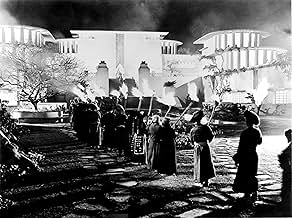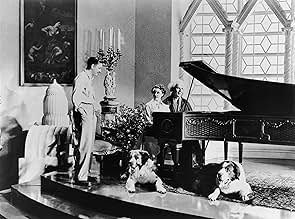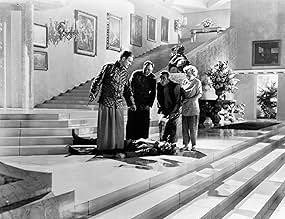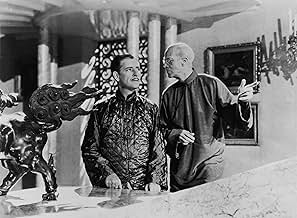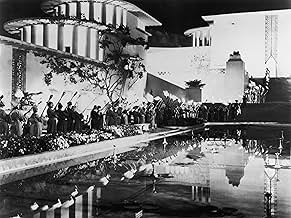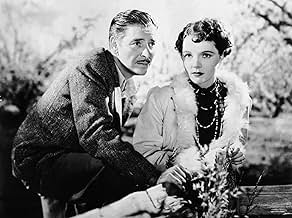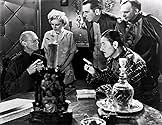VALUTAZIONE IMDb
7,6/10
15.286
LA TUA VALUTAZIONE
Aggiungi una trama nella tua linguaWhen a revered diplomat's plane is diverted and crashes in the peaks of Tibet, he and the other survivors are guided to an isolated monastery at Shangri-La, where they wrestle with the invit... Leggi tuttoWhen a revered diplomat's plane is diverted and crashes in the peaks of Tibet, he and the other survivors are guided to an isolated monastery at Shangri-La, where they wrestle with the invitation to stay.When a revered diplomat's plane is diverted and crashes in the peaks of Tibet, he and the other survivors are guided to an isolated monastery at Shangri-La, where they wrestle with the invitation to stay.
- Regia
- Sceneggiatura
- Star
- Vincitore di 2 Oscar
- 6 vittorie e 6 candidature totali
Norman Ainsley
- Embassy Club Steward
- (non citato nei titoli originali)
Chief John Big Tree
- Porter
- (non citato nei titoli originali)
Wyrley Birch
- Missionary
- (non citato nei titoli originali)
Beatrice Blinn
- Passenger
- (non citato nei titoli originali)
Hugh Buckler
- Lord Gainsford
- (non citato nei titoli originali)
Sonny Bupp
- Boy Being Carried to Plane
- (partecipazione non confermata)
- (non citato nei titoli originali)
John Burton
- Wynant
- (non citato nei titoli originali)
Tom Campbell
- Porter
- (non citato nei titoli originali)
Matthew Carlton
- Pottery Maker
- (non citato nei titoli originali)
Recensioni in evidenza
Fantasy filled film that shows the different facaets of human nature. Beautifully conceived by Frank Capra whose brilliant at making films with sentlemenity as main force. A masterpiece which was brutally cut during its threaitcal run and only recently has the film been somewhat restored. Thus, the complete version of Lost Horizon(1937) is one of many lost classics in history of film. Acting is excellent with everyone giving deep performances. An wonderful story with intriquing spirital symbolisms. Ronald Colman does a marvalous job as the good natured and tolerate Robert Conway. Personally I perfer Lost Horizons(1937) over Its a Wonderful Life(1946) because the main character in the former is more complex.
Frank Capra classic about a group of British citizens, led by diplomat Robert Conway (Ronald Colman), who flee a rebellion in China only to have their plane crash in the Himalayas. They are taken to Shangri-La, a magical place isolated in the mountains where people can leave behind the worries of civilization. They learn they will live for hundreds of years there but only if they never leave. The world-weary Conway is intrigued by the promise of this utopia but not everyone in his group feels the same way.
It's an ambitious undertaking for Capra, who made no other movies on the scale of this one (or with the budget). The costumes and Art Deco sets are beautiful. Great script from Robert Riskin, adapted from James Hilton's novel. Lovely, haunting score from Dimitri Tiomkin. Ronald Colman, an exceptional actor who never did a bad job that I've seen, gives a moving, sincere performance that ranks among the best of his impressive career. Sam Jaffe is also excellent in his small but important role as the High Lama. The rest of the wonderful cast includes John Howard, Jane Wyatt, Edward Everett Horton, H.B. Warner, Isabel Jewell, and Thomas Mitchell (the first of four movies he did with Capra). Jane Wyatt's swimming scene is probably the sexiest thing she ever did on film. The opening scenes are exciting and the climax is powerful. The middle of the film is where many people complain that it's slow or that it loses focus. I admit there is a chunk of the middle of the film, dealing with Colman and Wyatt falling in love, as well as everyone adjusting (or not adjusting) to Shangri-La that drags just a bit. But I never felt bored and I don't think it derails the film at all. The dialogue and performances in these scenes is still great. The original cut ran much longer and I can only imagine whether that version would be better or worse. As it is, seven minutes of footage is still missing from the current version. The dialogue for these scenes is intact, with production stills in place of the missing footage.
It's escapism, pure and simple. Many viewers will poke holes in the idea and philosophy behind Shangri-La, calling it naive and childish. Perhaps they're right; perhaps the cold, cynical reality of selfish human nature means such a utopia is impossible. But the thing about most of Frank Capra's films, and why he is probably my favorite director ever, was that he believed in telling uplifting, optimistic stories about us helping each other overcome our baser nature; that good can triumph over evil and there are such things as happy endings. While Lost Horizon is not really one of his "Capra-corn" movies, I think the basic Capra elements are still there, right down to the final shot. Most other directors would have likely gone for the sad or tragic ending, but Capra gives us one that is hopeful.
It's an ambitious undertaking for Capra, who made no other movies on the scale of this one (or with the budget). The costumes and Art Deco sets are beautiful. Great script from Robert Riskin, adapted from James Hilton's novel. Lovely, haunting score from Dimitri Tiomkin. Ronald Colman, an exceptional actor who never did a bad job that I've seen, gives a moving, sincere performance that ranks among the best of his impressive career. Sam Jaffe is also excellent in his small but important role as the High Lama. The rest of the wonderful cast includes John Howard, Jane Wyatt, Edward Everett Horton, H.B. Warner, Isabel Jewell, and Thomas Mitchell (the first of four movies he did with Capra). Jane Wyatt's swimming scene is probably the sexiest thing she ever did on film. The opening scenes are exciting and the climax is powerful. The middle of the film is where many people complain that it's slow or that it loses focus. I admit there is a chunk of the middle of the film, dealing with Colman and Wyatt falling in love, as well as everyone adjusting (or not adjusting) to Shangri-La that drags just a bit. But I never felt bored and I don't think it derails the film at all. The dialogue and performances in these scenes is still great. The original cut ran much longer and I can only imagine whether that version would be better or worse. As it is, seven minutes of footage is still missing from the current version. The dialogue for these scenes is intact, with production stills in place of the missing footage.
It's escapism, pure and simple. Many viewers will poke holes in the idea and philosophy behind Shangri-La, calling it naive and childish. Perhaps they're right; perhaps the cold, cynical reality of selfish human nature means such a utopia is impossible. But the thing about most of Frank Capra's films, and why he is probably my favorite director ever, was that he believed in telling uplifting, optimistic stories about us helping each other overcome our baser nature; that good can triumph over evil and there are such things as happy endings. While Lost Horizon is not really one of his "Capra-corn" movies, I think the basic Capra elements are still there, right down to the final shot. Most other directors would have likely gone for the sad or tragic ending, but Capra gives us one that is hopeful.
Along with A TALE OF TWO CITIES, THE PRISONER OF ZENDA, and THE LIGHT THAT FAILED, LOST HORIZON represented the best performance possible out of Ronald Colman. And his Robert Conway is the most modern of them (up to the time the films were made). LOST HORIZON is set (as James Hilton intended) in the 1930s, in war torn China. It is not the only reference in the story to the 1930s that Hilton puts into his fable of a paradise on earth.
Hilton had reason to fear about the world he lived in. The Great War (as the First World War was generally called in the 1930s) was still a savage and recent nightmare. The 1920s and 1930s saw dictatorships seize control of European and Asian state, and Democracy retreating everywhere. "Look at the world", says the High Lama (Sam Jaffe), "Is anything worse?" The High Lama is correct - the world is collapsing, and the so-called panaceas (Communist Russia, Nazi Germany, Fascist Italy and Spain, Imperial Japan and it's "Greater Asiatic Co-Prosperity Sphere") are worse than the seeming ineptitude and drift in badly divided France, weakened Britain, and recovering American.
Hilton took Conway, his brother George, Professor Edward Everett Horton, suspiciously quiet businessman Thomas Mitchell, and consumptive Isabel Elsom to an oasis (possibly the oasis) on that troubled old earth - Shangri La, or "the valley of the Blue Moon") where contentment and peace reigned and people could live, if not forever, far longer and more happily than in say 1937 Germany, Britain, France, Russia, Italy, the U.S., or Japan.
On the whole Capra catches the spirit of the novel - his sets were dismissed as being far to simplistic, but as simplicity is the hallmark of life at Shangri-La the critics seemed to miss the point. As a matter of fact, his sets (in a temperate valley in the Himalayas - a real impossibility) are more acceptable than the idiocies of the future world in the contemporary science fiction film THINGS TO COME, where H.G.Wells believes we should live in cities built in caves.
The acting is very good, particularly Sam Jaffe's ancient High Lama (always shot in shadows). Remember, he is over two hundred years old. Today, because Jaffe had a long career in Hollywood (despite being blacklisted in the 1950s), we think of him as an old man in THE ASPHALT JUNGLE or as "Dr. Zorba" in the series BEN CASEY. So we think he must have looked old in real life when LOST HORIZON was shot. Actually, he was in his thirties or forties, so he was not that old. But he gave a performance that suggested he was an old man.
Another member of the cast that I would wish to bring up for consideration is John Howard. He is not recalled by film fans too much, but Mr. Howard was a good, competent actor. That he played Hugh "Bulldog" Drummond in a series of "B" features in the late thirties makes it ironic that he played the younger brother of Ronald Colman here, who had begun the talking picture segment of his career with the same role. Howard does not have a British accent, but he does show the adoration of the younger brother for his famous sibling, and the growing anger and contempt he develops when brother Robert fails to plan for their leaving this prison they were dragged to - note how he wants to return with a bomber to destroy Shangri-La. It is one of the two roles in major films that John Howard is remembered for, the other being "George Kittridge", the erstwhile fiancé of Tracy Lord (Katherine Hepburn) in THE PHILADELPHIA STORY, who is pushed aside by both Cary Grant and James Stewart.
As it is one of Howard's best roles, it is nice that when the film was restored (as well as possible) in the 1980s, Howard (one of the three surviving cast members) was able to appreciate it - many of the missing sequences were his scenes. Howard was very happy at the restoration result.
Now, one or two notes that may help appreciate the film a little more. Who is Robert Conway supposed to be? He is called, by the High Lama, "Conway, the empire builder." He is supposedly able to do impossible things - hence the admiration of his brother. When he returns to Shangri-La at the end, the comment of the man telling the story is that Conway's journeys by himself back to his valley was beyond what ordinary men could do. So who is Conway? Well, in 1937, the model for Robert Conway was dead, from a motorcycle accident, for two years. It was, of course, Thomas Edward Lawrence "of Arabia", who had never been in Tibet (officially, anyway) but had served time in the Indian subcontinent area on government business in the 1920s. Quite a model for an empire builder.
The character played by Thomas Mitchell is also based on a real person. Harry Barnard's real name (which I have forgotten) is that of an international financier whose vast empire collapsed ruining thousands of investors. It turns out Mitchell's character is based on Samuel Insull, a mid western utilities empire builder (out of Chicago) whose financial doings brought about his collapse in the Great Depression. Insull fled in disguise to Greece, but was found on a dirty freighter, and returned to the U.S. (where he would stand trial for fraud, but be acquitted). Edward Everett Horton's anger at Mitchell when he learned the latter's identity is understandable. Mitchell's involvement in installing new pipes in Shangri-La mirrors Insull's early days, when he was an electrician, and an assistant to Thomas Edison.
The use of these two real figures as the basis of the characters helped contemporary audiences to accept the background of the plot of the film.
Hilton had reason to fear about the world he lived in. The Great War (as the First World War was generally called in the 1930s) was still a savage and recent nightmare. The 1920s and 1930s saw dictatorships seize control of European and Asian state, and Democracy retreating everywhere. "Look at the world", says the High Lama (Sam Jaffe), "Is anything worse?" The High Lama is correct - the world is collapsing, and the so-called panaceas (Communist Russia, Nazi Germany, Fascist Italy and Spain, Imperial Japan and it's "Greater Asiatic Co-Prosperity Sphere") are worse than the seeming ineptitude and drift in badly divided France, weakened Britain, and recovering American.
Hilton took Conway, his brother George, Professor Edward Everett Horton, suspiciously quiet businessman Thomas Mitchell, and consumptive Isabel Elsom to an oasis (possibly the oasis) on that troubled old earth - Shangri La, or "the valley of the Blue Moon") where contentment and peace reigned and people could live, if not forever, far longer and more happily than in say 1937 Germany, Britain, France, Russia, Italy, the U.S., or Japan.
On the whole Capra catches the spirit of the novel - his sets were dismissed as being far to simplistic, but as simplicity is the hallmark of life at Shangri-La the critics seemed to miss the point. As a matter of fact, his sets (in a temperate valley in the Himalayas - a real impossibility) are more acceptable than the idiocies of the future world in the contemporary science fiction film THINGS TO COME, where H.G.Wells believes we should live in cities built in caves.
The acting is very good, particularly Sam Jaffe's ancient High Lama (always shot in shadows). Remember, he is over two hundred years old. Today, because Jaffe had a long career in Hollywood (despite being blacklisted in the 1950s), we think of him as an old man in THE ASPHALT JUNGLE or as "Dr. Zorba" in the series BEN CASEY. So we think he must have looked old in real life when LOST HORIZON was shot. Actually, he was in his thirties or forties, so he was not that old. But he gave a performance that suggested he was an old man.
Another member of the cast that I would wish to bring up for consideration is John Howard. He is not recalled by film fans too much, but Mr. Howard was a good, competent actor. That he played Hugh "Bulldog" Drummond in a series of "B" features in the late thirties makes it ironic that he played the younger brother of Ronald Colman here, who had begun the talking picture segment of his career with the same role. Howard does not have a British accent, but he does show the adoration of the younger brother for his famous sibling, and the growing anger and contempt he develops when brother Robert fails to plan for their leaving this prison they were dragged to - note how he wants to return with a bomber to destroy Shangri-La. It is one of the two roles in major films that John Howard is remembered for, the other being "George Kittridge", the erstwhile fiancé of Tracy Lord (Katherine Hepburn) in THE PHILADELPHIA STORY, who is pushed aside by both Cary Grant and James Stewart.
As it is one of Howard's best roles, it is nice that when the film was restored (as well as possible) in the 1980s, Howard (one of the three surviving cast members) was able to appreciate it - many of the missing sequences were his scenes. Howard was very happy at the restoration result.
Now, one or two notes that may help appreciate the film a little more. Who is Robert Conway supposed to be? He is called, by the High Lama, "Conway, the empire builder." He is supposedly able to do impossible things - hence the admiration of his brother. When he returns to Shangri-La at the end, the comment of the man telling the story is that Conway's journeys by himself back to his valley was beyond what ordinary men could do. So who is Conway? Well, in 1937, the model for Robert Conway was dead, from a motorcycle accident, for two years. It was, of course, Thomas Edward Lawrence "of Arabia", who had never been in Tibet (officially, anyway) but had served time in the Indian subcontinent area on government business in the 1920s. Quite a model for an empire builder.
The character played by Thomas Mitchell is also based on a real person. Harry Barnard's real name (which I have forgotten) is that of an international financier whose vast empire collapsed ruining thousands of investors. It turns out Mitchell's character is based on Samuel Insull, a mid western utilities empire builder (out of Chicago) whose financial doings brought about his collapse in the Great Depression. Insull fled in disguise to Greece, but was found on a dirty freighter, and returned to the U.S. (where he would stand trial for fraud, but be acquitted). Edward Everett Horton's anger at Mitchell when he learned the latter's identity is understandable. Mitchell's involvement in installing new pipes in Shangri-La mirrors Insull's early days, when he was an electrician, and an assistant to Thomas Edison.
The use of these two real figures as the basis of the characters helped contemporary audiences to accept the background of the plot of the film.
One of my favorite books growing up was James Hilton's classic 1933 book, "Lost Horizon", and I believe it motivated a great deal of my current wanderlust. Even though I have had the misfortune of seeing the disastrous 1973 musical remake when I was young, the original 1937 film adaptation has been a film I have wanted to see for years, but for whatever reason, it was next to impossible to uncover. Apparently, bastardized versions have shown up on TV through the years. Now we are fortunate to have this 1999 restoration spearheaded by UCLA film archivist Robert Gitt to match as closely as possible to Frank Capra's original 132-minute running time.
Similar to what was done with George Cukor's "A Star Is Born", "Lost Horizon" is presented with its complete soundtrack, but missing footage had to be found through other sources, even 16-mm prints recorded from TV broadcasts, and in a few scenes, production stills were sadly the only option to fill in the gaps. Consequently, there is a variable quality to the print, but when one thinks that much of this footage could have been completely lost, the visual lapses are more than forgivable. Now that I have seen Capra's vision of the book, I can now understand why it's a cinematic classic though I have to concede not as timeless as one would hope.
The fanciful plot centers on Robert Conway, a top-level English diplomat about to become the Foreign Secretary, who helps refugees and assorted others from war-ravaged China. A motley crew of passengers led by Conway boards a plane that is skyjacked toward the Himalayas where it crash lands in a desolate spot of Tibet. They are eventually met by a sect of locals who takes them to a paradise called Shangri-La. The focus of the story then becomes how each of the plane survivors responds to this utopian existence. With his instantly recognizable mellifluous tone, Ronald Colman is perfectly cast as Conway, the only one who embraces this seemingly perfect haven from the outset. He captures the natural curiosity and open romanticism of his character with his trademark erudite manner.
The rest of the cast is a gallery of stock characters fleshed out by the variable quality of the performances. H.B. Warner plays Chang with the requisite serenity of his vague, mysterious character; and Jane Wyatt - two decades before playing the perfect suburban wife and mother in "Father Knows Best" - is surprisingly saucy as Sondra, the young schoolteacher who has Conway brought to Shangri-La. She even has a brief nude swimming scene. John Howard unfortunately overplays the thankless role of Conway's obstreperous brother George to the point where I groan every time he appears on screen. A similar feeling comes over me when I see Edward Everett Horton's overly pixilated and fey turn as Lovett and Sam Jaffe's bug-eyed, ethereal High Lama. Isabel Jewell and Thomas Mitchell fare better as a dying prostitute and a fugitive swindler, respectively.
The set designs for the Shangri-La lamasery by Stephen Goossón are intriguing in that they look like a post-modern tribute to Frank Lloyd Wright's prairie architecture, though one could argue that the exteriors also resemble a fancy Miami Beach resort hotel. I also imagine that the isolationist philosophy espoused by the High Lama may have been at odds with pre-WWII patriotic fervor, though the more lingering problem is the racism apparent in the casting (e.g., non-Asians like Warner playing inscrutable Asians) and the portrayal of the Tibetan porters as gun-toting derelicts. However, for all its flaws, the movie has some really stunning camera-work by Joseph Walker, surprisingly masterful special effects (for a near-poverty row studio like Columbia), Dmitri Tiomkin's stirring musical score and a powerful sense of mysticism that gives the film a genuine soul. It is no accident that Capra, the most idealistic of the master filmmakers, helmed this movie because a more cynical mindset could have easily sabotaged the entire venture.
The DVD is a wonderful package. First, there is a fascinating photo montage documentary with narration provided by film historian Kendall Miller, which gives a true feeling of how Capra approached the production. Gitt and film critic Charles Champlin provide audio commentary on an alternate track of the film with Gitt very informative about the exhaustive restoration process and Champlin more in awe of the result. There is even an alternative ending included that Columbia chief Harry Cohn insisted on filming and using upon release, but it had thankfully been dropped two weeks later. This is a genuine treat for cinemaphiles, as there are few films that make such a compelling case for seeking out one's personal utopia.
Similar to what was done with George Cukor's "A Star Is Born", "Lost Horizon" is presented with its complete soundtrack, but missing footage had to be found through other sources, even 16-mm prints recorded from TV broadcasts, and in a few scenes, production stills were sadly the only option to fill in the gaps. Consequently, there is a variable quality to the print, but when one thinks that much of this footage could have been completely lost, the visual lapses are more than forgivable. Now that I have seen Capra's vision of the book, I can now understand why it's a cinematic classic though I have to concede not as timeless as one would hope.
The fanciful plot centers on Robert Conway, a top-level English diplomat about to become the Foreign Secretary, who helps refugees and assorted others from war-ravaged China. A motley crew of passengers led by Conway boards a plane that is skyjacked toward the Himalayas where it crash lands in a desolate spot of Tibet. They are eventually met by a sect of locals who takes them to a paradise called Shangri-La. The focus of the story then becomes how each of the plane survivors responds to this utopian existence. With his instantly recognizable mellifluous tone, Ronald Colman is perfectly cast as Conway, the only one who embraces this seemingly perfect haven from the outset. He captures the natural curiosity and open romanticism of his character with his trademark erudite manner.
The rest of the cast is a gallery of stock characters fleshed out by the variable quality of the performances. H.B. Warner plays Chang with the requisite serenity of his vague, mysterious character; and Jane Wyatt - two decades before playing the perfect suburban wife and mother in "Father Knows Best" - is surprisingly saucy as Sondra, the young schoolteacher who has Conway brought to Shangri-La. She even has a brief nude swimming scene. John Howard unfortunately overplays the thankless role of Conway's obstreperous brother George to the point where I groan every time he appears on screen. A similar feeling comes over me when I see Edward Everett Horton's overly pixilated and fey turn as Lovett and Sam Jaffe's bug-eyed, ethereal High Lama. Isabel Jewell and Thomas Mitchell fare better as a dying prostitute and a fugitive swindler, respectively.
The set designs for the Shangri-La lamasery by Stephen Goossón are intriguing in that they look like a post-modern tribute to Frank Lloyd Wright's prairie architecture, though one could argue that the exteriors also resemble a fancy Miami Beach resort hotel. I also imagine that the isolationist philosophy espoused by the High Lama may have been at odds with pre-WWII patriotic fervor, though the more lingering problem is the racism apparent in the casting (e.g., non-Asians like Warner playing inscrutable Asians) and the portrayal of the Tibetan porters as gun-toting derelicts. However, for all its flaws, the movie has some really stunning camera-work by Joseph Walker, surprisingly masterful special effects (for a near-poverty row studio like Columbia), Dmitri Tiomkin's stirring musical score and a powerful sense of mysticism that gives the film a genuine soul. It is no accident that Capra, the most idealistic of the master filmmakers, helmed this movie because a more cynical mindset could have easily sabotaged the entire venture.
The DVD is a wonderful package. First, there is a fascinating photo montage documentary with narration provided by film historian Kendall Miller, which gives a true feeling of how Capra approached the production. Gitt and film critic Charles Champlin provide audio commentary on an alternate track of the film with Gitt very informative about the exhaustive restoration process and Champlin more in awe of the result. There is even an alternative ending included that Columbia chief Harry Cohn insisted on filming and using upon release, but it had thankfully been dropped two weeks later. This is a genuine treat for cinemaphiles, as there are few films that make such a compelling case for seeking out one's personal utopia.
I watched this film for the first time as a 10 year old and its effects on my willingness to be a optimistic idealist have always been led by my memories of this hope inspiring tribute to the need for the human being to find Heaven in this life. Perhaps Lost Horizon could have been that spark that enabled me to find just that. Like all films from another era do not judge this film for its apparent imperfections, rather for what it offered the audiences of that time (1937), hope that all would be well when man would recognize that his time is always better spent broadening his horizons of understanding. Frank Capra's guides his audiences through danger and turmoil to that place which dreams are made of, when we all make the effort to make it happen.
Lo sapevi?
- QuizThe year after this film was released the owner of a prosperous theater chain hired an architect who designed a mansion that was inspired by the Shangri-La lamasery in this film. Located in Denver, Colorado, it still exists today.
- BlooperEchoing the words of the critic, James Agate: 'The best film I've seen for ages, but will somebody please tell me how they got the grand piano along a footpath on which only one person can walk at a time with rope and pickaxe and with a sheer drop of three thousand feet or so?'
- Curiosità sui creditiBob Gitt of the UCLA Film & Television Archives claims the original opening sequence in 1937 had title cards "Conway has been sent to evacuate ninety white people before they're butchered in a local revolution" was changed in 1942 for a special reissue during WWII. The title cards read "before innocent Chinese people were butchered by Japanese hordes." This was to bolster propaganda against the Japanese.
- Versioni alternativeSome of the music in the restored version is dubbed into different sections than the ones in the 118 minute cut version. For example, the moment in which Robert Conway ('Ronald Colman') discovers that the High Lama is really Father Perrault i accompanied by soft music in the cut version, while in the restored version this moment is played with no music.
- ConnessioniEdited from Tempeste sul Monte Bianco (1930)
- Colonne sonoreWiegenlied (Lullaby) Op. 49 No. 4
(1868) (uncredited)
Composed by Johannes Brahms
English translator unknown
Sung a cappella by children at Shangri-La
I più visti
Accedi per valutare e creare un elenco di titoli salvati per ottenere consigli personalizzati
- How long is Lost Horizon?Powered by Alexa
- Why was Maria so anxious to leave Shangri La?
- Why is Maria so anxious to leave Shangri La?
- Is the version usually seen faithful to the director's intentions?
Dettagli
Botteghino
- Budget
- 4.000.000 USD (previsto)
- Tempo di esecuzione2 ore 12 minuti
- Colore
- Proporzioni
- 1.37 : 1
Contribuisci a questa pagina
Suggerisci una modifica o aggiungi i contenuti mancanti



